3D Scanning of Wood–Plastic Composite Decking After Cyclic Thermal Action
Abstract
1. Introduction
2. Materials and Methods
2.1. Test Sample and Climatic Impacts
2.2. 3D Scanning Method and Inspection Analysis
2.3. Statistical Analysis
- (P)
- Point on the sample. Sets of results were obtained for testing, each for the same exposure time and the same sample. The sample points on a plane surface (1 < 5) and a fluted surface (6 < 10) were tested separately. A total of 42 sets of four to five results were tested.
- (S)
- Sample. Sets of results for different samples were obtained for testing, but each for the same point and exposure times. Fifty sets of four to five results were tested.
- (E)
- Exposure times. Sets of results for different exposure times were obtained for the test, but each for the same point and the same sample. A total of fifty sets of four to five results were tested.
- (a)
- Effect of sample and exposure time for each point on the sample separately (ten sets of results, each at a different point on the sample).
- (b)
- Effect of the point on the sample and exposure time for each sample separately. (ten sets of results: five for five samples for points 15 and five for points 6 ÷ 10).
- (c)
- Effect of sample and point for each exposure time separately (ten sets of results: five for five exposure times for points 15 and five for points 6 ÷ 10).
2.4. Microstructure SEM Analysis
3. Results
3.1. Measurement Inspection
3.2. Microstructure Analysis
3.3. Statistical Results
- (P)
- In most sets (60%) in which the variable was a point in the sample, the null hypothesis that the set came from a normally distributed population was not confirmed.
- (S)
- The sets in which the variable was a sample, the Shapiro–Wilk test confirmed the hypothesis that the sets came from a normally distributed population in 96% of the sets in which the variable was a sample.
- (E)
- The Shapiro–Wilk test confirmed the hypothesis that the sets came from a normally distributed population in 90% of the sets, in which exposure time was a variable.
3.4. Measurement Uncertainty
4. Discussion
- Because in most cases (nine out of ten when the second influencing factor was the point in the sample and eight out of ten when the second influencing factor was exposure time) the differences between the results for individual samples were found to be statistically insignificant, it can be concluded that the deformation differences for individual samples are statistically insignificant. This means that the effect of the sample is insignificant; therefore, the set of results obtained from several samples can be regarded as a set in which the dispersion of results is random and the mean of the results for the individual samples can be regarded as the authoritative result. Confirmation of such conclusions can also be found in the Shapiro–Wilk tests, which, in sets where the sample was variable, confirmed the hypothesis of a normal distribution in 96% of cases.
- In all sets of results, a two-way analysis of variance (ANOVA) showed statistically significant differences in deformation at different points on the samples, both when the other influencing factors were the sample and the exposure time.
- For deformation differences according to the exposure time, the situation is not clear. Only half of the ANOVA results indicated that these differences were significant.
- 5% in thickness, which for a thickness of 25 mm is <1.25 mm
- 1.2% in width, which for a width of 180 mm is 2.16 mm.
5. Conclusions
Author Contributions
Funding
Institutional Review Board Statement
Informed Consent Statement
Data Availability Statement
Conflicts of Interest
References
- Morreale, M.; Liga, A.; Mistretta, M.C.; Ascione, L.; La Mantia, F.P. Mechanical, Thermomechanical and Reprocessing Behavior of Green Composites from Biodegradable Polymer and Wood Flour. Materials 2015, 8, 7536–7548. [Google Scholar] [CrossRef] [PubMed]
- Hejna, A.; Barczewski, M.; Kosmela, P.; Mysiukiewicz, O.; Piasecki, A.; Tercjak, A. Compatibility of Sustainable Mater-Bi/Poly(ε-Caprolactone)/Cellulose Biocomposites as a Function of Filler Modification. Materials 2023, 16, 6814. [Google Scholar] [CrossRef] [PubMed]
- Peças, P.; Carvalho, H.; Salman, H.; Leite, M. Natural Fibre Composites and Their Applications: A Review. J. Compos. Sci. 2018, 2, 66. [Google Scholar] [CrossRef]
- Sudoł, E.; Kozikowska, E.; Szewczak, E. Artificial Weathering Resistance Test Methods for Building Performance Assessment of Profiles Made of Natural Fibre-Reinforced Polymer Composites. Materials 2022, 15, 296. [Google Scholar] [CrossRef]
- Publishing, B. Global Bio-Based Composite Material Market Analysis Report (Report Code: AVM232B). Available online: https://www.bccresearch.com/market-research/advanced-materials/bio-composites-market.html?srsltid=AfmBOook68u3WozEAvDQjmizH0gqvRtITw4vqCpYTSEP2mVEUyTy5JPa (accessed on 21 November 2024).
- Mazzanti, V.; Mollica, F. A Review of Wood Polymer Composites Rheology and Its Implications for Processing. Polymers 2020, 12, 2304. [Google Scholar] [CrossRef] [PubMed]
- Ndiaye, D.; Fanton, E.; Morlat-Therias, S.; Vidal, L.; Tidjani, A.; Gardette, J.L. Durability of Wood Polymer Composites: Part 1. Influence of Wood on the Photochemical Properties. Compos. Sci. Technol. 2008, 68, 2779–2784. [Google Scholar] [CrossRef]
- Rowell, R.M. Advances and Challenges of Wood Polymer Composites—Fpl_2006_rowell001.Pdf. In Proceedings of the Pacific Rim Bio-Based Composites Symposium, Kuala Lumpur, Malaysia, 20–23 November 2006; pp. 2–12. [Google Scholar]
- Dale Ellis, W. Wood-Polymer Composites: Review of Processes and Properties. In Proceedings of the Molecular Crystals and Liquid Crystals Science and Technology, Section A: Molecular Crystals and Liquid Crystals; Gordon and Breach Science Publishers Inc.: London, UK, 2000; Volume 353, pp. 75–84. [Google Scholar]
- Marcuello, C.; Foulon, L.; Chabbert, B.; Aguié-Béghin, V.; Molinari, M. Atomic Force Microscopy Reveals How Relative Humidity Impacts the Young’s Modulus of Lignocellulosic Polymers and Their Adhesion with Cellulose Nanocrystals at the Nanoscale. Int. J. Biol. Macromol. 2020, 147, 1064–1075. [Google Scholar] [CrossRef] [PubMed]
- Nukala, S.G.; Kong, I.; Kakarla, A.B.; Tshai, K.Y.; Kong, W. Preparation and Characterisation of Wood Polymer Composites Using Sustainable Raw Materials. Polymers 2022, 14, 3183. [Google Scholar] [CrossRef] [PubMed]
- EN 15534-4:2014; Composites Made from Cellulose-Based Materials and Thermoplastics (Usually Called Wood-Polymer Composites (WPC) or Natural Fibre Composites (NFC)—2014, Part 4: Specifications for Decking Profiles and Tiles. European Committee for Standardization (CEN): Brussels, Belgium, 2014.
- European Organisation for Technical Assessment (EOTA). European Assessment Document—EAD 190005-00-0402, Terrace Decking Kit; European Organisation for Technical Assessment (EOTA): Brussels, Belgium, 2017. [Google Scholar]
- Yilmaz, B.; Marques, V.R.; Donmez, M.B.; Cuellar, A.R.; Lu, W.E.; Abou-Ayash, S.; Çakmak, G. Influence of 3D Analysis Software on Measured Deviations of CAD-CAM Resin Crowns from Virtual Design File: An In-Vitro Study. J. Dent. 2022, 118, 103933. [Google Scholar] [CrossRef]
- Taraben, J.; Morgenthal, G. Automated Linking of 3D Inspection Data for Damage Analysis. In Proceedings of the Bridge Maintenance, Safety, Management, Life-Cycle Sustainability and Innovations—Proceedings of the 10th International Conference on Bridge Maintenance, Safety and Management, IABMAS 2020; CRC Press/Balkema: Leiden, The Netherlands, 2021; pp. 3714–3720. [Google Scholar]
- Szilvási-Nagy, M.; Mátyási, G. Analysis of STL Files. Math. Comput. Model. 2003, 38, 945–960. [Google Scholar] [CrossRef]
- Botín-Sanabria, D.M.; Mihaita, S.; Peimbert-García, R.E.; Ramírez-Moreno, M.A.; Ramírez-Mendoza, R.A.; Lozoya-Santos, J.D.J. Digital Twin Technology Challenges and Applications: A Comprehensive Review. Remote Sens. 2022, 14, 1335. [Google Scholar] [CrossRef]
- Buonamici, F.; Carfagni, M.; Furferi, R.; Governi, L.; Lapini, A.; Volpe, Y. Reverse Engineering Modeling Methods and Tools: A Survey. Comput. Aided. Des. Appl. 2018, 15, 443–464. [Google Scholar] [CrossRef]
- Lim, K.Y.H.; Zheng, P.; Chen, C.H. A State-of-the-Art Survey of Digital Twin: Techniques, Engineering Product Lifecycle Management and Business Innovation Perspectives. J. Intell. Manuf. 2020, 31, 1313–1337. [Google Scholar] [CrossRef]
- Stałowska, P.; Suchocki, C.; Rutkowska, M. Crack Detection in Building Walls Based on Geometric and Radiometric Point Cloud Information. Autom. Constr. 2022, 134, 104065. [Google Scholar] [CrossRef]
- Szewczak, E.; Winkler-Skalna, A.; Czarnecki, L. Sustainable Test Methods for Construction Materials and Elements. Materials 2020, 13, 606. [Google Scholar] [CrossRef] [PubMed]
- Szewczak, E.; Piekarczuk, A. Performance Evaluation of the Construction Products as a Research Challenge. Small Error—Big Difference in Assessment? Bull. Polish Acad. Sci. Tech. Sci. 2016, 64, 675–686. [Google Scholar] [CrossRef][Green Version]
- Szewczak, E. Does Standardisation Ensure a Reliable Assessment of the Performance of Construction Products? Standards 2022, 2, 260–275. [Google Scholar] [CrossRef]
- Working Group 1 of the Joint Committee for Guides in Metrology (JCGM/WG 1). Evaluation of Measurement Data—Guide to the Expression of Uncertainty in Measurement, 1st ed.; Committee for Guides in Metrology: Sevres, France, 2008; Volume 50, ISBN 9267101889. [Google Scholar]
- ISO 16474-3:2021; Paints and Varnishes. Methodsof Exposure to Laboratory Light Sources. Part 3: Fluorescent UV Lamps. International Organization for Standardization: Geneva, Switzerland, 2021.
- EN 927-6:2018; Paints and Varnishes—Coating Materials and Coating Systems for Exterior Wood—Part 6: Exposure of Wood Coatings to Artificial Weathering Using Fluorescent UV Lamps and Water. European Committee for Standardisation: Brussels, Belgium, 2018.
- SHINING 3D Tech Co., Ltd. FreeScan Trio User Manual; SHINING 3D Tech Co., Ltd.: Hangzhou, China, 2024. [Google Scholar]
- Kot, S.M.; Jakubowski, J.; Sokołowski, A. Statystyka; Wyd. 2, po.; Difin: Warsaw, Poland, 2011; ISBN 9788376413495. [Google Scholar]
- Keskin, S. Comparison of Several Univariate Normality Tests Regarding Type I Error Rate and Power of the Test in Simulation Based Small Samples. J. Appl. Sci. Res. 2006, 2, 296–300. [Google Scholar]
- Razali, N.M.; Wah, Y.B. Power Comparisons of Shapiro-Wilk, Kolmogorov-Smirnov, Lilliefors and Anderson-Darling Tests. J. Stat. Model. Anal. 2011, 2, 21–33. [Google Scholar]
- EN 15534-1:2014; Composites made from cellulose-based materials and thermoplastics (usually called wood-polymer composites (WPC) or natural fibre composites (NFC)) - Part 1: Test methods for characterisation of compounds and products. European Committee for Standardisation: Brussels, Belgium, 2014.
- Gao, X.; Li, Q.; Cheng, W.; Han, G.; Xuan, L. Optimization of High Temperature and Pressurized Steam Modified Wood Fibers for High-Density Polyethylene Matrix Composites Using the Orthogonal Design Method. Materials 2016, 9, 847. [Google Scholar] [CrossRef]
- Wang, X.; Song, K.; Ou, R. Effects of Carbon Black and Titanium Dioxide on Ultraviolet Weathering of Wood Flour-HDPE/Using Multi-Phase Co-Extrusion Technology. BioResources 2017, 12, 6173–6186. [Google Scholar] [CrossRef]
- Gunwant, D. Moisture Resistance Treatments of Natural Fiber-Reinforced Composites: A Review. Compos. Interfaces 2024, 31, 979–1047. [Google Scholar] [CrossRef]
- Turku, I.; Kärki, T.; Puurtinen, A. Durability of Wood Plastic Composites Manufactured from Recycled Plastic. Heliyon 2018, 4, e00559. [Google Scholar] [CrossRef] [PubMed]
- Andrady, A.L.; Heikkilä, A.M.; Pandey, K.K.; Bruckman, L.S.; White, C.C.; Zhu, M.; Zhu, L. Effects of UV Radiation on Natural and Synthetic Materials. Photochem. Photobiol. Sci. 2023, 22, 1177–1202. [Google Scholar] [CrossRef] [PubMed]

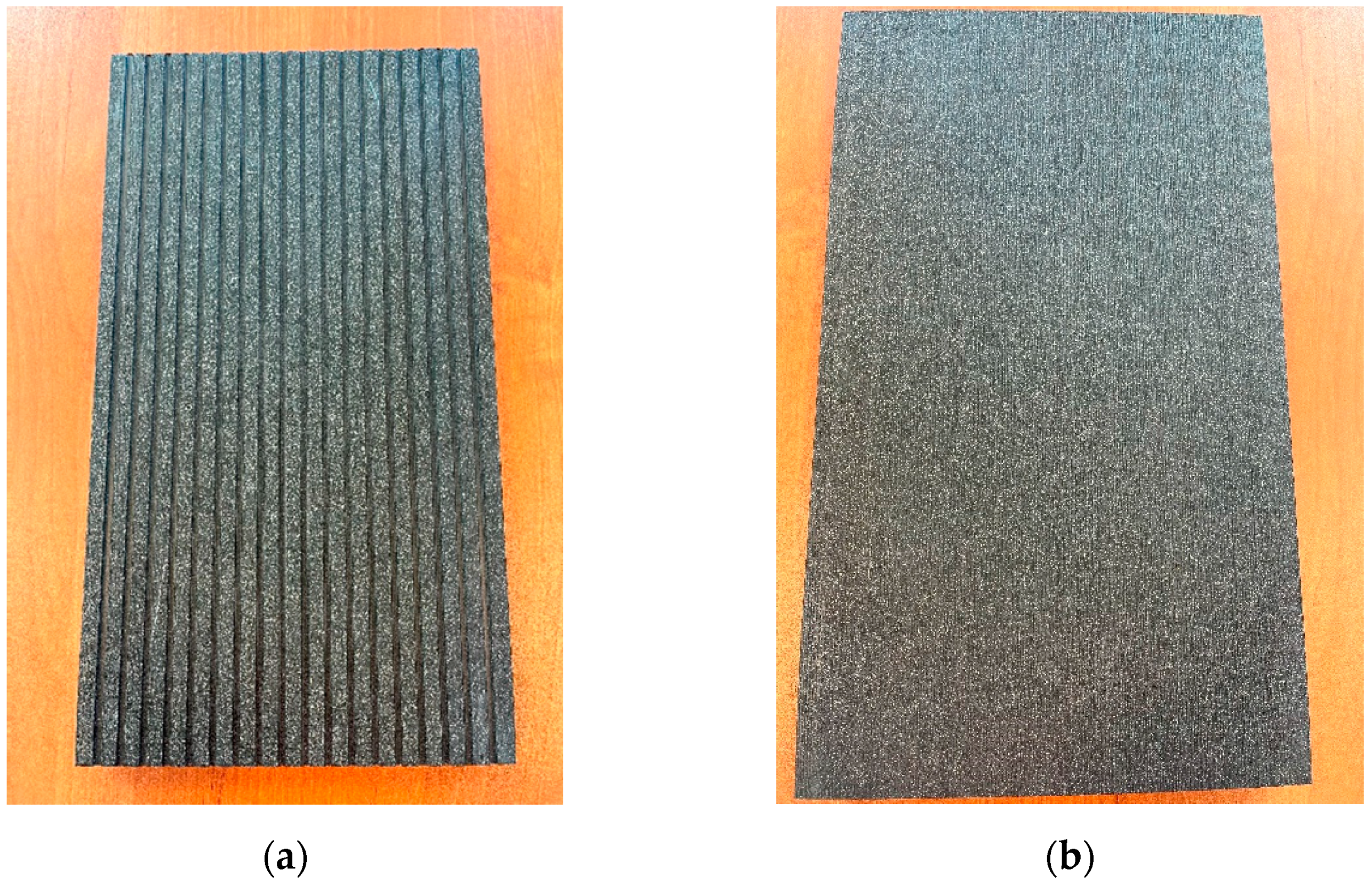

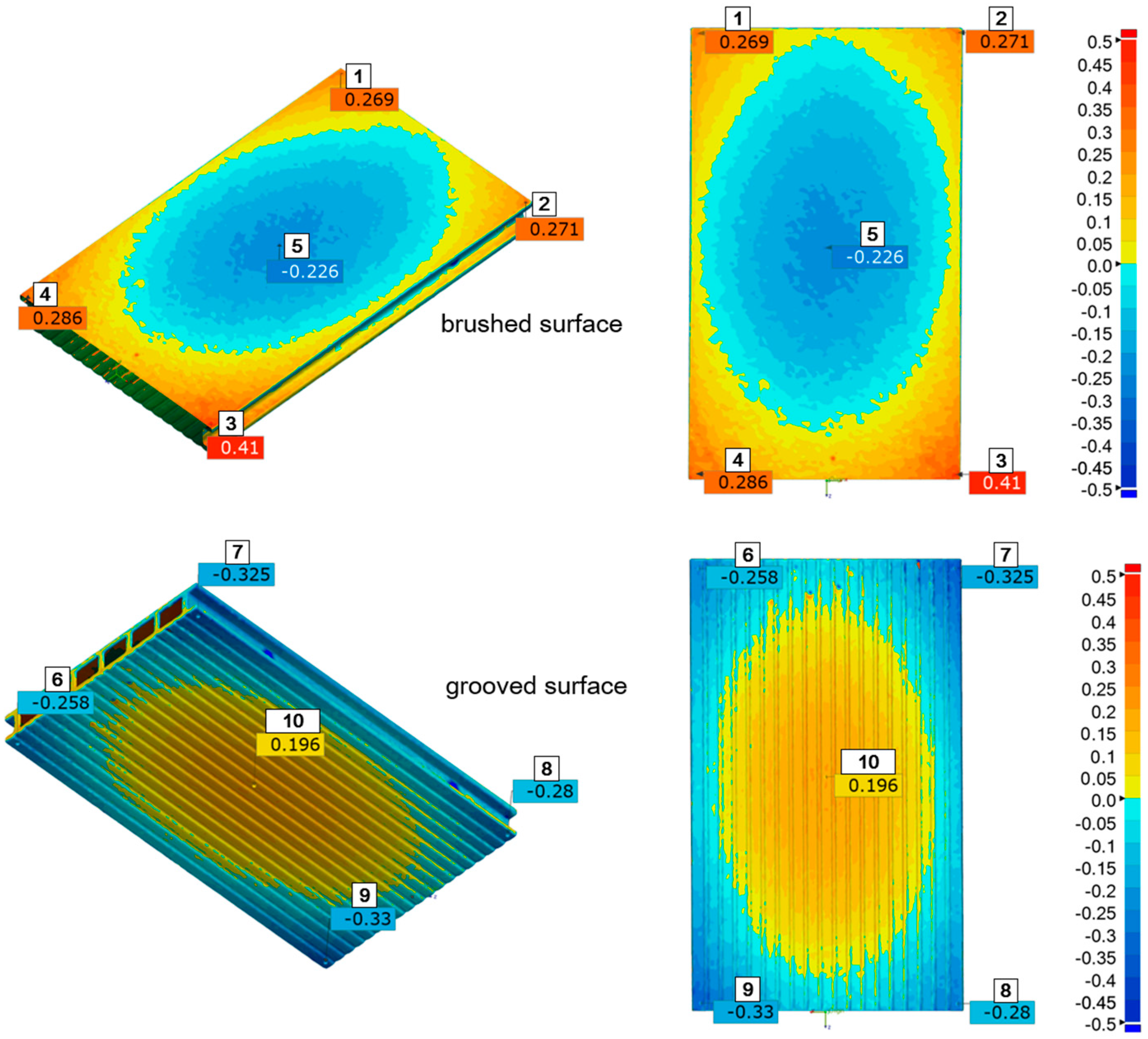
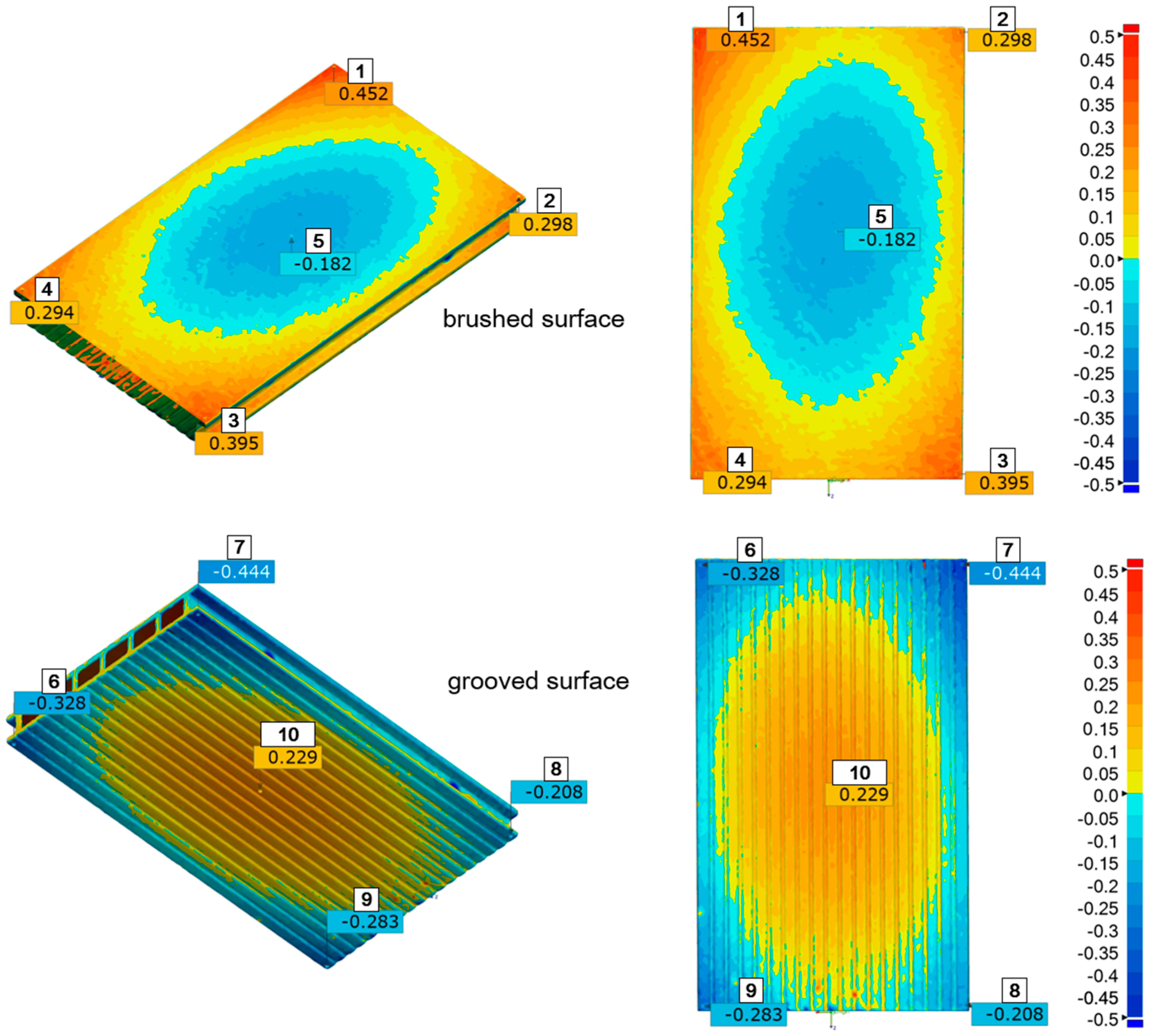

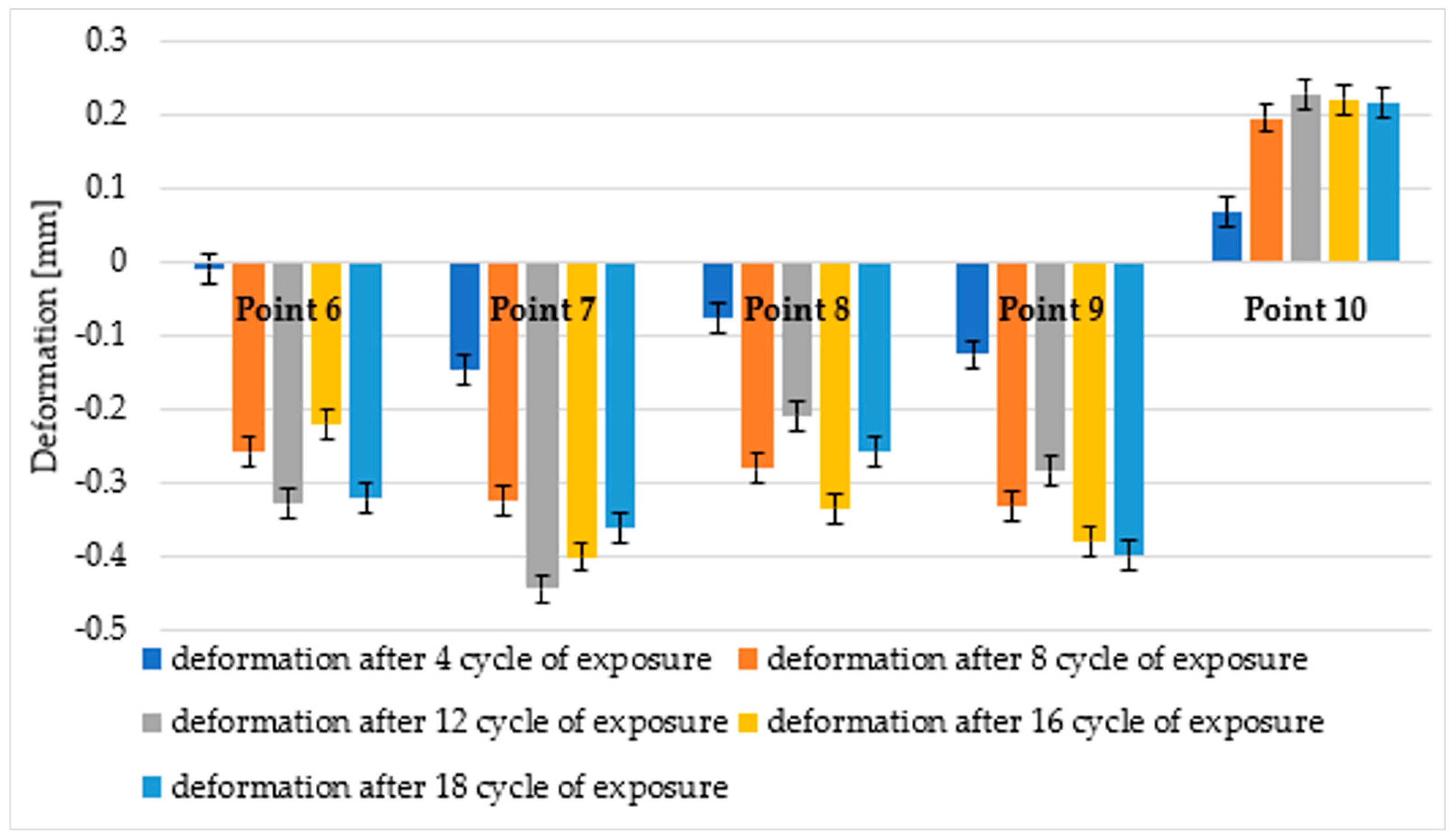

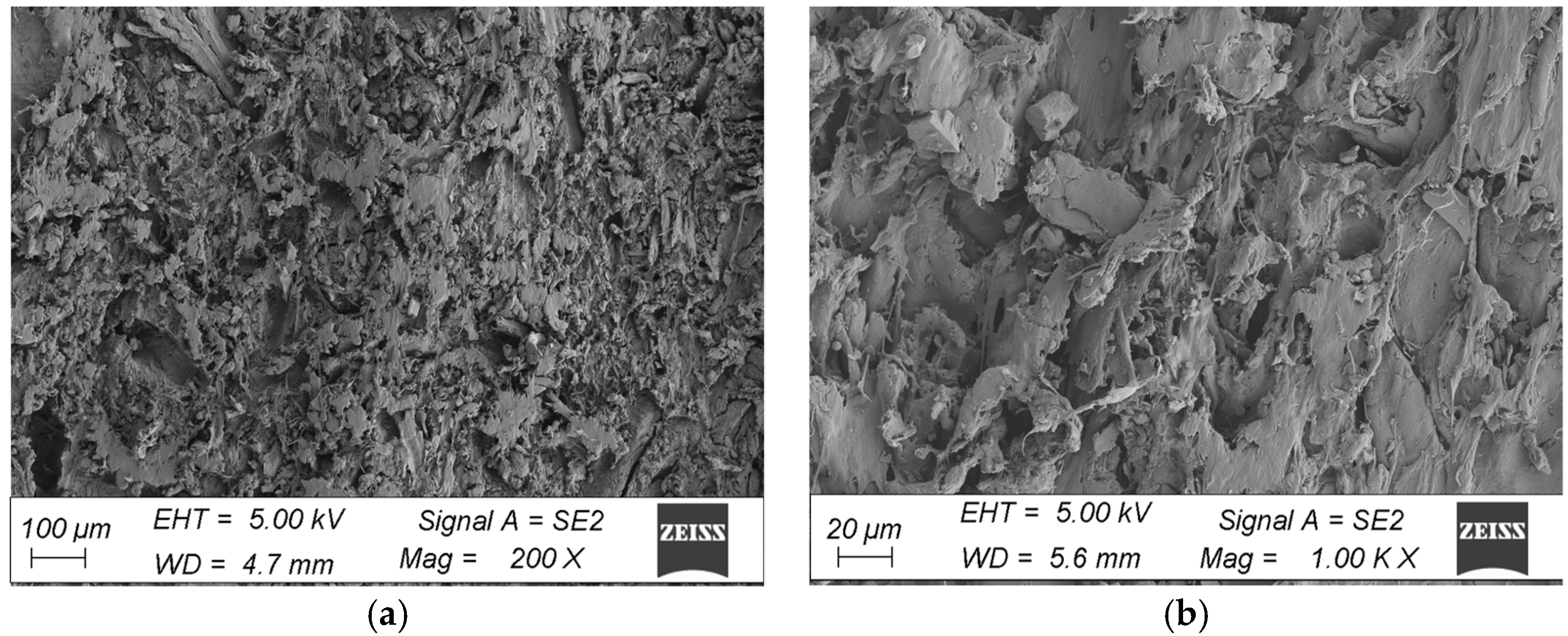
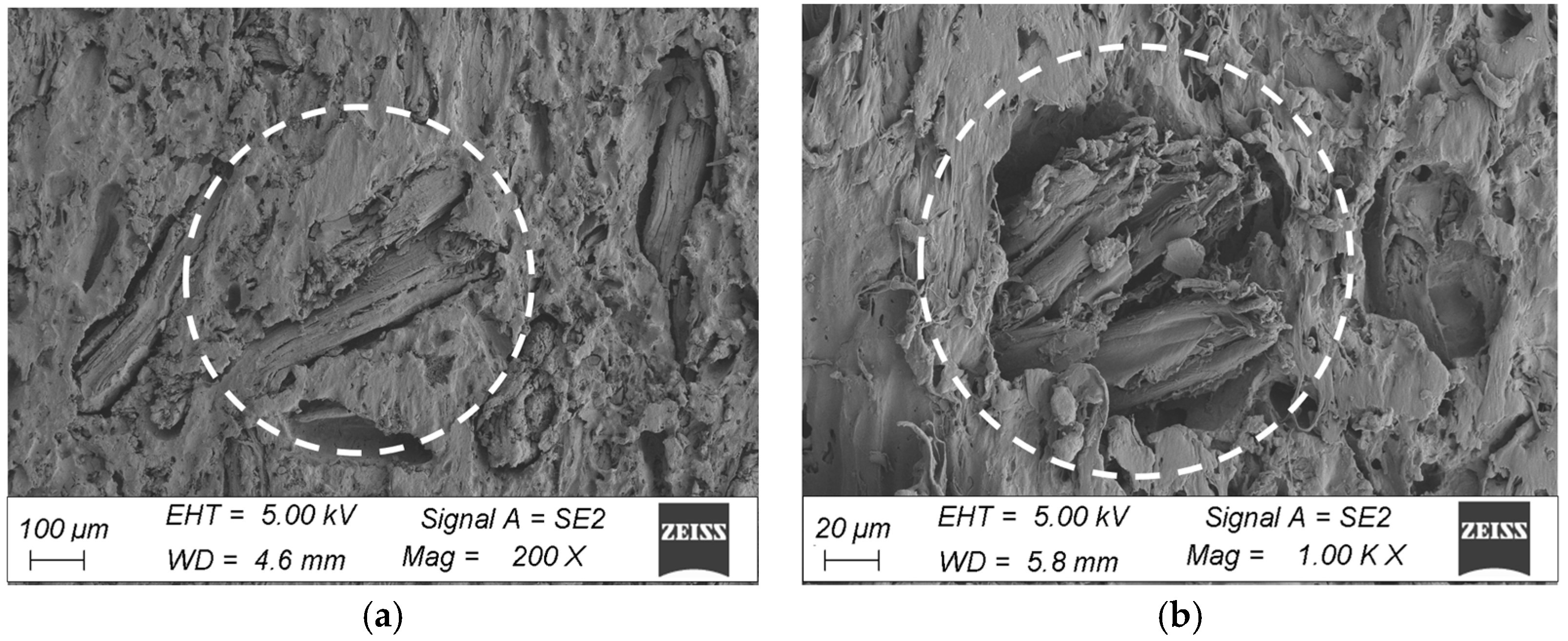
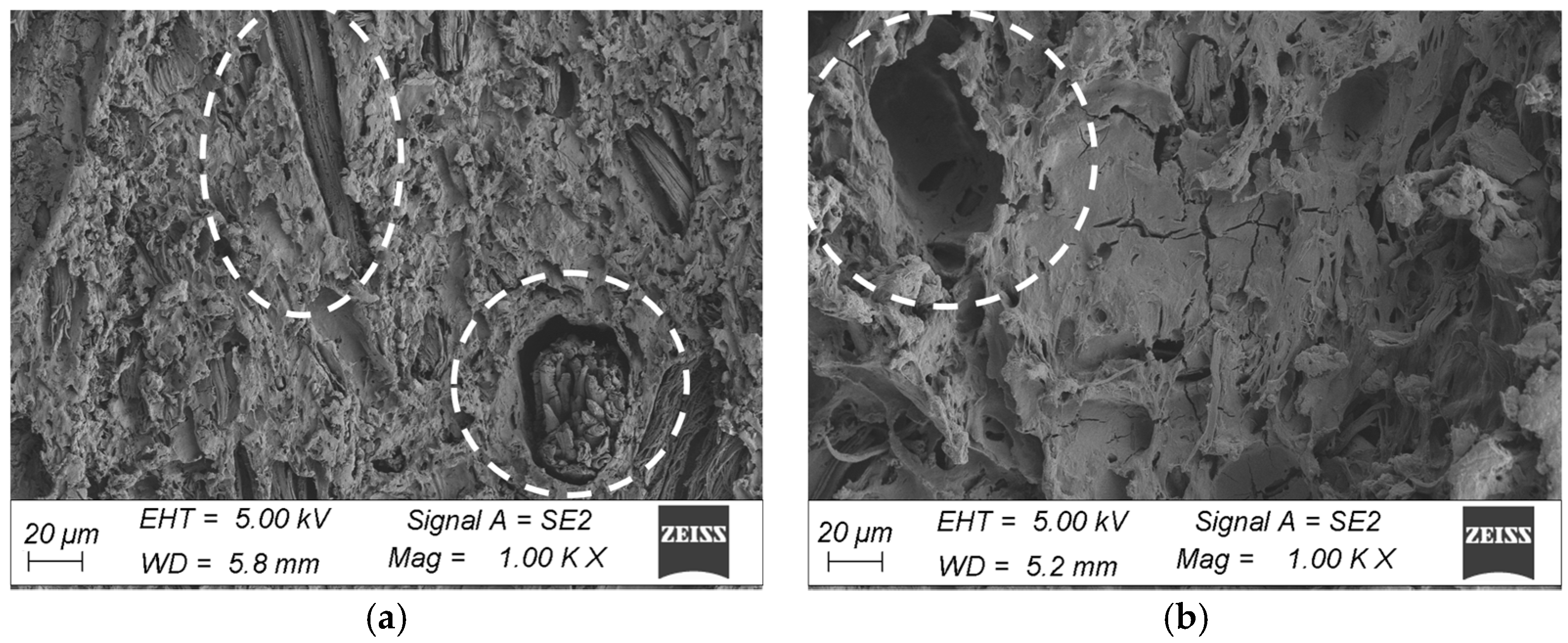
| Total Duration of Exposure | Total Number of Cycles | Exposure Pattern Over the Cycle |
|---|---|---|
| 3024 | 18 | 24 h of humidification by condensation at temperature 45 ± 3 °C 168 h of alternating irradiation and sprinkling, in the sequence: (a) 2.5 h of irradiation with UVA-340 lamps, irradiance 0.89 watt per square metre (340 nm), temperature (Black Standard Thermometer) 60 ± 3 °C, (b) 0.5 h of water sprinkling, no UV, sprinkling rate 6–7 litre per minute. |
| (a) | |||||
| Sample Point Number | |||||
| Influences | 1 | 2 | 3 | 4 | 5 |
| Effect of the sample | SSD | SSD | |||
| Effect of the time of exposure | SSD | SSD | SSD | SSD | |
| Sample Point Number | |||||
| Influences | 6 | 7 | 8 | 9 | 10 |
| Effect of the sample | |||||
| Effect of the time of exposure | SSD | SSD | |||
| (b) | |||||
| Sample | |||||
| Influences | A | B | C | D | E |
| Effect of the point on the sample (points 1–5) | SSD | SSD | SSD | SSD | SSD |
| Effect of exposure time of exposure (points 1–5) | SSD | ||||
| Effect of the point on the sample (points 6–10) | SSD | SSD | SSD | SSD | SSD |
| Effect of exposure time of exposure (points 6–10) | SSD | SSD | SSD | ||
| (c) | |||||
| Time of Exposure-Number of Cycles | |||||
| Influences | 4 Cycles | 8 Cycles | 12 Cycles | 16 Cycles | 18 Cycles |
| Effect of the Sample (points 1–5) | SSD | ||||
| Effect of the point on the sample (points 1–5) | SSD | SSD | SSD | SSD | SSD |
| Effect of the sample (points 6–10) | |||||
| Effect of the point on the sample (points 6–10) | SSD | SSD | SSD | SSD | SSD |
| The Point on the Sample | Mean Deformation After 4 Cycles | 4÷ 8 Cycles | 8 ÷ 12 Cycles | 12÷ 16 Cycles | 16÷ 18 Cycles | 8 ÷ 18 Cycles | Total Mean Deformation After 18 Cycles |
|---|---|---|---|---|---|---|---|
| Deformation Differences, mm | |||||||
| Point 1 | 0.146 | 0.177 | 0.035 | −0.042 | 0.104 | 0.097 | 0.42 |
| Point 2 | 0.179 | 0.145 | 0.007 | 0.023 | 0.058 | 0.088 | 0.41 |
| Point 3 | 0.251 | 0.142 | 0.059 | −0.078 | 0.045 | 0.026 | 0.42 |
| Point 4 | 0.223 | 0.167 | 0.006 | −0.074 | 0.063 | −0.005 | 0.38 |
| Point 5 | −0.082 | −0.166 | −0.009 | 0.015 | 0.020 | 0.027 | −0.22 |
| Point 6 | −0.175 | −0.208 | 0.002 | −0.031 | 0.040 | 0.011 | −0.37 |
| Point 7 | −0.178 | −0.189 | −0.088 | 0.111 | −0.051 | −0.028 | −0.39 |
| Point 8 | −0.102 | −0.278 | 0.022 | −0.015 | 0.089 | 0.097 | −0.28 |
| Point 9 | −0.159 | −0.208 | −0.026 | 0.041 | −0.030 | −0.015 | −0.38 |
| Point 10 | 0.139 | 0.0780 | 0.033 | −0.051 | −0.049 | −0.066 | 0.15 |
| Exposure | Point 1 | Point 2 | Point 3 | Point 4 | |
| Deformation Differences, mm | |||||
| 4 cycles | Point 2 | −0.032 | - | - | - |
| Point 3 | −0.105 | −0.073 | - | - | |
| Point 4 | −0.076 | −0.044 | 0.029 | - | |
| Point 5 | −0.229 | 0.261 | 0.334 | 0.305 | |
| 8 cycles | Point 2 | −0.001 | - | - | - |
| Point 3 | −0.070 | −0.069 | - | - | |
| Point 4 | −0.066 | −0.065 | 0.004 | - | |
| Point 5 | 0.571 | 0.572 | 0.642 | 0.638 | |
| 12 cycles | Point 2 | 0.028 | - | - | - |
| Point 3 | −0.094 | −0.121 | - | - | |
| Point 4 | −0.037 | −0.065 | 0.057 | - | |
| Point 5 | 0.616 | 0.588 | 0.709 | 0.652 | |
| 16 cycles | Point 2 | −0.038 | - | - | - |
| Point 3 | −0.058 | −0.020 | - | - | |
| Point 4 | −0.005 | 0.033 | 0.053 | - | |
| Point 5 | 0.558 | 0.596 | 0.616 | 0.563 | |
| 18 cycles | Point 2 | 0.009 | - | - | - |
| Point 3 | 0.001 | −0.008 | - | - | |
| Point 4 | 0.036 | 0.028 | 0.036 | - | |
| Point 5 | 0.642 | 0.634 | 0.642 | 0.606 | |
| Exposure | Point 6 | Point 7 | Point 8 | Point 9 | |
| Difference, mm | |||||
| 4 cycles | Point 7 | 0.002 | - | - | - |
| Point 8 | −0.073 | −0.075 | - | - | |
| Point 9 | −0.017 | −0.019 | 0.056 | - | |
| Point 10 | −0.315 | −0.317 | −0.241 | −0.298 | |
| 8 cycles | Point 7 | 0.017 | - | - | - |
| Point 8 | 0.003 | −0.014 | - | - | |
| Point 9 | 0.017 | 0.000 | 0.014 | - | |
| Point 10 | 0.601 | 0.584 | 0.598 | 0.584 | |
| 12 cycles | Point 7 | −0.073 | - | - | - |
| Point 8 | 0.023 | 0.096 | - | - | |
| Point 9 | −0.011 | 0.062 | −0.034 | - | |
| Point 10 | 0.632 | 0.705 | 0.609 | 0.643 | |
| 16 cycles | Point 7 | 0.069 | - | - | - |
| Point 8 | 0.039 | −0.030 | - | - | |
| Point 9 | 0.061 | −0.008 | 0.022 | - | |
| Point 10 | 0.612 | 0.543 | 0.573 | 0.551 | |
| 18 cycles | Point 7 | −0.022 | - | - | - |
| Point 8 | 0.089 | 0.111 | - | - | |
| Point 9 | −0.009 | 0.014 | −0.097 | - | |
| Point 10 | 0.523 | 0.546 | 0.435 | 0.532 | |
Disclaimer/Publisher’s Note: The statements, opinions and data contained in all publications are solely those of the individual author(s) and contributor(s) and not of MDPI and/or the editor(s). MDPI and/or the editor(s) disclaim responsibility for any injury to people or property resulting from any ideas, methods, instructions or products referred to in the content. |
© 2024 by the authors. Licensee MDPI, Basel, Switzerland. This article is an open access article distributed under the terms and conditions of the Creative Commons Attribution (CC BY) license (https://creativecommons.org/licenses/by/4.0/).
Share and Cite
Piekarczuk, A.; Szewczak, E.; Kozikowska, E.; Gołębiowski, Ł. 3D Scanning of Wood–Plastic Composite Decking After Cyclic Thermal Action. Materials 2025, 18, 97. https://doi.org/10.3390/ma18010097
Piekarczuk A, Szewczak E, Kozikowska E, Gołębiowski Ł. 3D Scanning of Wood–Plastic Composite Decking After Cyclic Thermal Action. Materials. 2025; 18(1):97. https://doi.org/10.3390/ma18010097
Chicago/Turabian StylePiekarczuk, Artur, Ewa Szewczak, Ewelina Kozikowska, and Łukasz Gołębiowski. 2025. "3D Scanning of Wood–Plastic Composite Decking After Cyclic Thermal Action" Materials 18, no. 1: 97. https://doi.org/10.3390/ma18010097
APA StylePiekarczuk, A., Szewczak, E., Kozikowska, E., & Gołębiowski, Ł. (2025). 3D Scanning of Wood–Plastic Composite Decking After Cyclic Thermal Action. Materials, 18(1), 97. https://doi.org/10.3390/ma18010097







